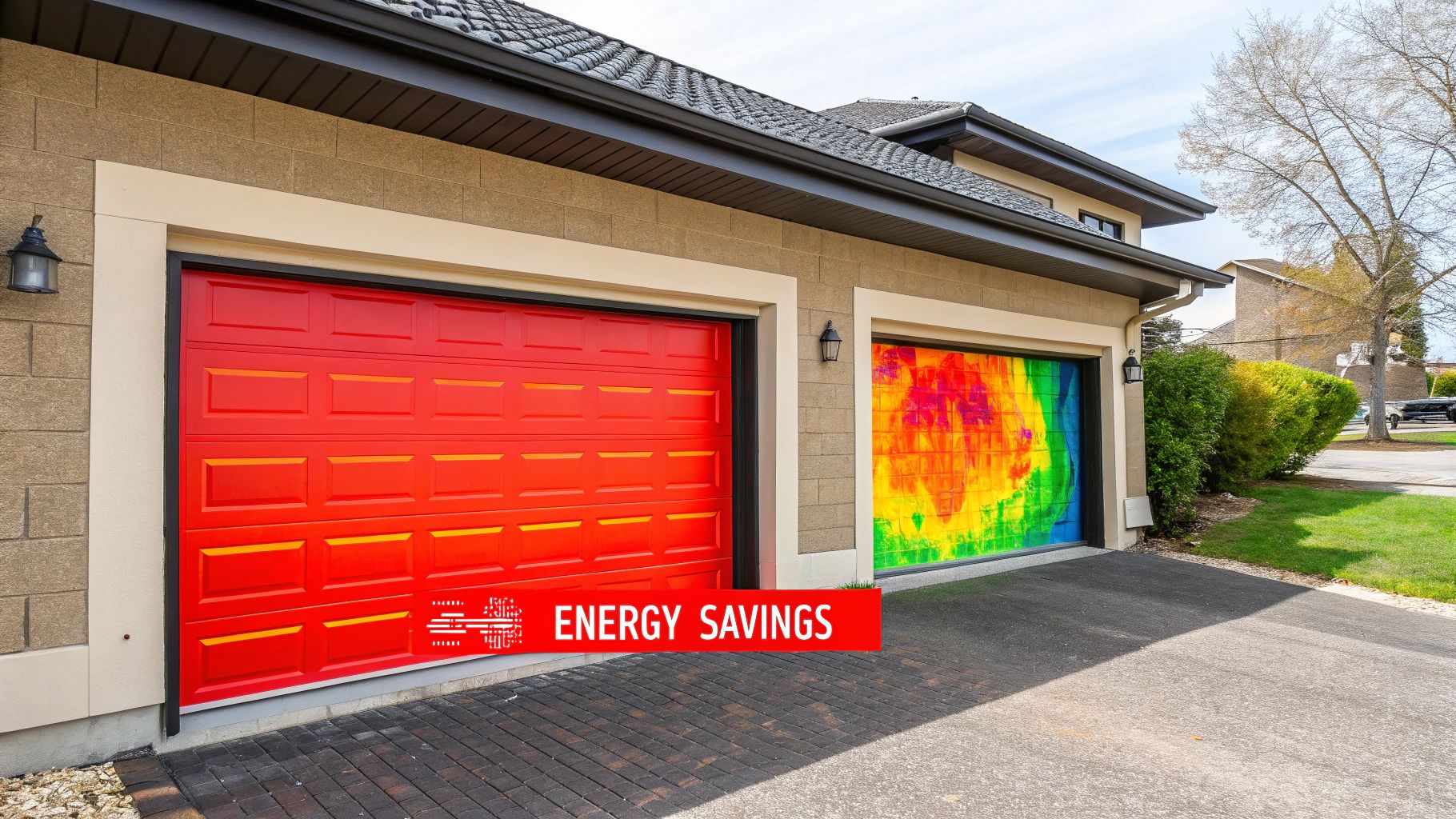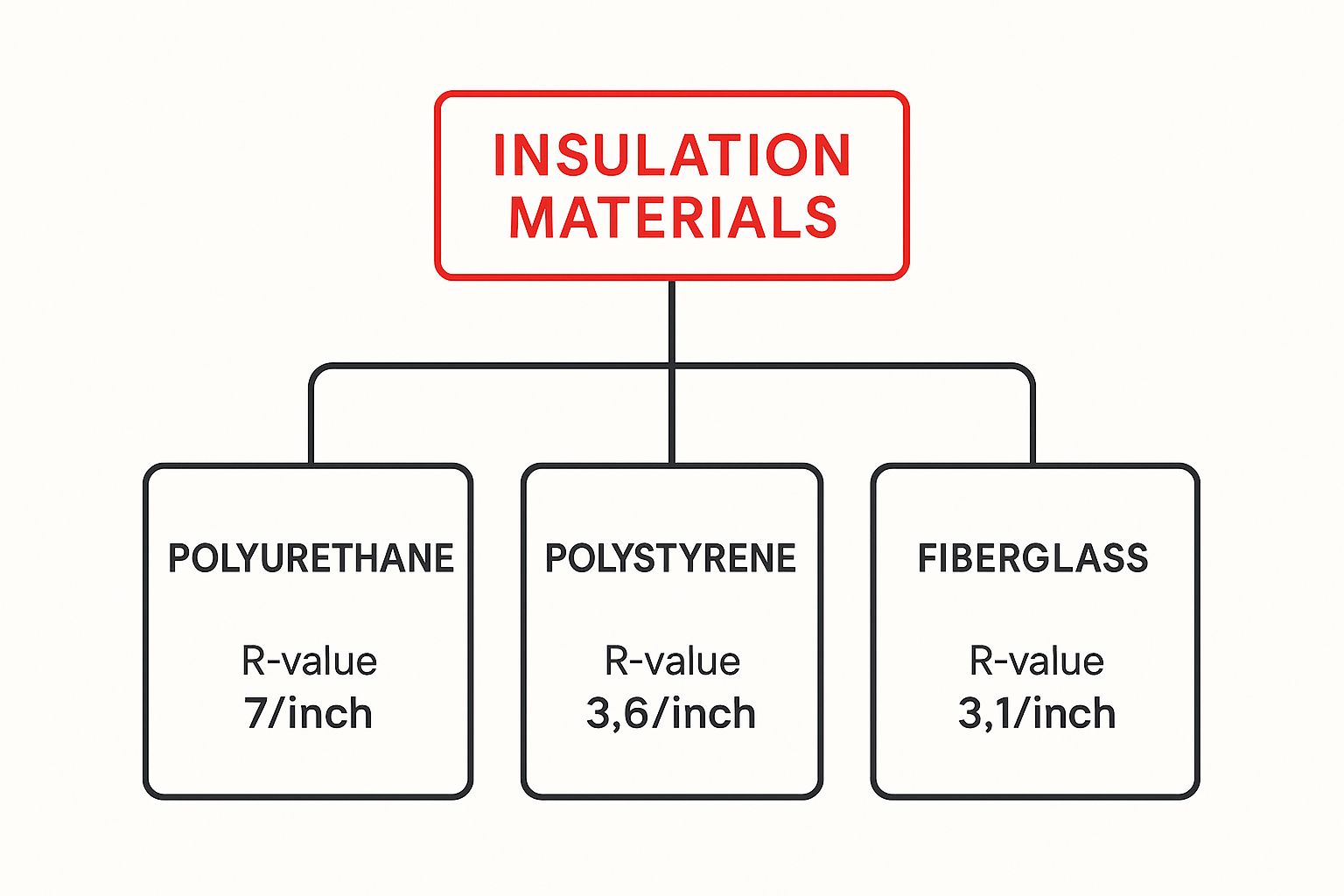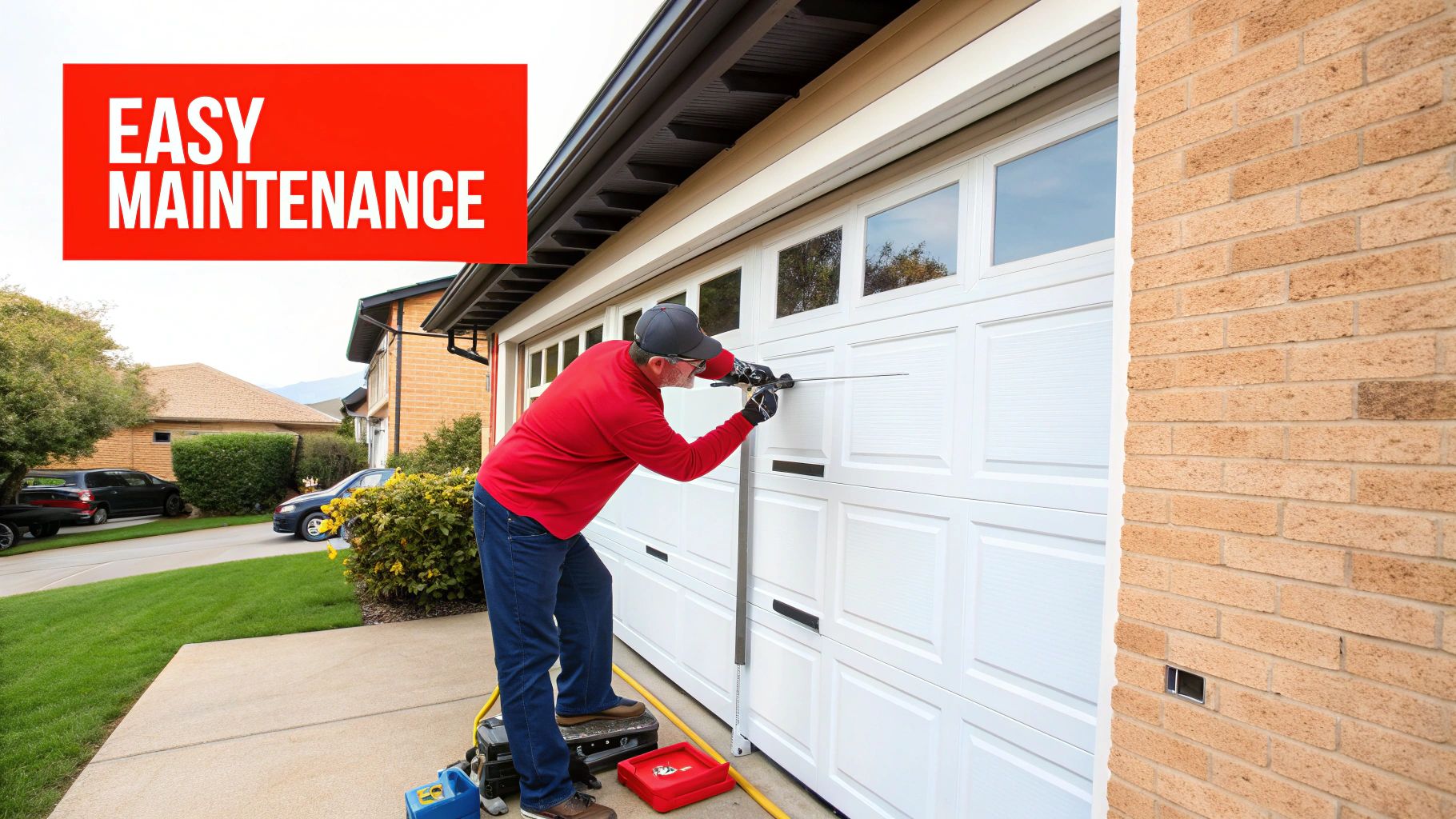If your HVAC system seems to be fighting a losing battle against the Texas heat or an Oklahoma cold snap, your garage door might be the culprit. For many properties, it's a massive, uninsulated gap in the building's thermal envelope, letting expensive conditioned air escape. In a climate like ours, that thermal inefficiency forces your system into overdrive.
An energy-efficient garage door isn't just a minor home improvement; it's a critical infrastructure upgrade that reinforces your entire energy strategy, leading to quantifiable savings and a more stable indoor environment for both homes and businesses.
The Overlooked Impact of Your Garage Door on Energy Bills

As the largest moving part of your property, a garage door can account for up to 30% of your building's primary facade. When it's a single, uninsulated layer of steel, it becomes a massive thermal bridge, actively working against your climate control efforts. This is a significant operational issue for the millions of homes and businesses across Texas and Oklahoma with attached garages.
Consider a sweltering Dallas summer. An uninsulated door absorbing solar radiation can elevate garage temperatures to over 130°F. This heat doesn't stay in the garage; it radiates through shared walls and ceilings, increasing the load on your air conditioning by as much as 20%.
Conversely, during a Lawton winter cold snap, that same door allows frigid air to infiltrate, turning the garage into a walk-in freezer that leeches heat from adjacent living or working spaces, forcing your furnace to run continuously.
The Quantifiable Cost of an Inefficient Door
This constant thermal battle directly impacts your bottom line. A poorly sealed, uninsulated garage door can significantly inflate monthly utility bills. This isn't just a residential concern. For commercial facilities like an auto shop in Abilene or a warehouse in Shawnee, inefficient overhead doors can equate to thousands of dollars in wasted energy annually, impacting operating margins.
While the garage door is a primary focus, a comprehensive energy audit should always begin by assessing your home's overall energy appetite. Understanding the big picture ensures your investments are targeted for maximum impact.
Actionable Insight: According to the U.S. Department of Energy, an insulated garage door can reduce energy loss through the garage by over 70%. This stabilizes the garage temperature and can lower your overall heating and cooling costs by up to 20%.
Investing in an energy-efficient model is a strategic capital improvement that delivers tangible returns. At Overhead Door Co. of Tex-Oma, we help clients select doors that provide immediate comfort and long-term financial benefits. Whether you need a simple garage door repair to replace a faulty seal or a new residential garage door installation, closing this energy gap is a smart business and homeownership decision. Our commercial door services are designed to ensure your facility is both secure and energy-smart.
Understanding R-Value: The Benchmark for Thermal Performance
When researching energy-efficient garage doors, the most critical metric you'll encounter is R-value. R-value is the industry standard for measuring thermal resistance, or a material's ability to impede heat flow. The higher the R-value, the greater its insulating power.
This measurement is critical for maintaining a stable garage temperature, whether you're combating 100°F Texas summers or 20°F Oklahoma winters. For instance, a basic uninsulated steel door has a negligible R-value, often rated at R-0, offering no thermal protection. In contrast, a premium triple-layer door injected with polyurethane foam can achieve an R-value of R-18 or higher, providing superior thermal separation.
For any attached garage, a high R-value is non-negotiable. It prevents the garage from becoming a heat sink in the summer or an icebox in the winter, which directly reduces the operational strain on your HVAC system and lowers energy consumption.
Decoding Insulation Materials and Their Impact on R-Value
A door's R-value is determined by the type and thickness of the insulation within its panels. The two primary materials used in the industry are polystyrene and polyurethane.

As the data shows, polyurethane provides nearly double the insulating performance per inch compared to polystyrene. Its ability to fill every crevice within the door panel also enhances structural rigidity and sound dampening.
This focus on advanced insulation is driving market growth. The global insulated garage doors market was valued at USD 3.69 billion in 2024, a clear indicator that consumers and businesses are prioritizing long-term energy efficiency.
Recommended Garage Door R-Values for Texas and Oklahoma
| Garage Type & Use Case | Climate Condition | Recommended Minimum R-Value | Ideal Insulation Type |
|---|---|---|---|
| Detached Garage (Storage Only) | Mild to Hot Summers, Mild Winters | R-6 to R-9 | Polystyrene |
| Attached Garage (No Living Space Above) | Hot Summers, Cold Snaps in Winter | R-9 to R-13 | High-Density Polystyrene or Polyurethane |
| Attached Garage (With Living Space Above) | Extreme Heat & Cold Exposure | R-13 to R-18+ | Polyurethane |
| Commercial/Workshop (Climate Controlled) | Frequent Use, Temperature Sensitive | R-16+ | Polyurethane |
Actionable Tip: For any garage in Texas or Oklahoma with living space above it, specifying a door with an R-value of at least R-13 is a best practice. This creates a sufficient thermal buffer to protect the floor of the room above from extreme temperature fluctuations.
Why R-Value Matters for Your Property
Selecting the correct R-value translates to tangible benefits for your property.
- For Homeowners: If your garage is attached, especially with a bonus room above, a high R-value (R-12 or higher) is a critical investment. The door functions as an essential part of your home's insulated envelope. You can learn more about how a garage door R-value impacts your home.
- For Businesses: For climate-controlled warehouses, auto repair shops, or distribution centers, an insulated overhead door is an operational necessity. It protects temperature-sensitive inventory, improves employee comfort and productivity, and reduces overhead costs.
The right R-value doesn't just lower utility bills; it transforms your garage from a liability into a functional, comfortable extension of your home or business.
While the door is critical, it performs best within a complete system. True energy efficiency often involves broader home insulation upgrades. By selecting a door with an R-value engineered for the Texoma climate, you are making a strategic investment that pays dividends in comfort and savings.
How Materials and Construction Affect Efficiency
While R-value is the key performance indicator, the door's construction and materials are what deliver that performance reliably. A door's structural integrity determines its longevity, security, and ability to withstand the demanding weather cycles of the Texoma region.
The industry standard for energy-efficient garage doors is insulated steel. Steel offers an optimal balance of strength, durability, and cost-effectiveness. When combined with a high-density insulating core, it creates a formidable barrier against both thermal transfer and physical impact.
The Power of Layered Construction
The engineering behind a high-performance door lies in its layered construction. There are three primary construction types, each offering a distinct level of thermal efficiency and durability.
- Single-Layer (Pan Doors): A basic, hollow door made from a single sheet of steel. It offers no insulation (R-0) and minimal structural rigidity.
- Double-Layer (Insulation-Backed): This construction adds a layer of polystyrene insulation to the back of the steel skin. It provides a moderate R-value and improved dent resistance.
- Triple-Layer (Sandwich Construction): The gold standard for performance. This design sandwiches a thick core of polyurethane or polystyrene insulation between two layers of steel, creating a robust and highly effective thermal barrier.
This multi-layer construction also provides significant sound attenuation, reducing the intrusion of exterior noise—a valuable benefit for properties near busy roads.
Industry Insight: A triple-layer door with polyurethane insulation not only provides maximum R-value but also enhances security and reduces operational noise. The sandwich construction creates a stronger, quieter, and more durable door system.
The Critical Role of Thermal Breaks and Seals
Even a door with an R-18 rating will fail if heat can bypass the insulation through its frame and edges. This is why two engineering features are critical: thermal breaks and weather seals.
A thermal break is a material of low thermal conductivity (like a polymer) used to separate the interior and exterior steel skins of the door. This design feature prevents outside temperatures from conducting through the metal frame, which would otherwise create a "thermal bridge" and lead to energy loss and condensation.
Equally vital are the weather seals. A high-quality bottom astragal and full-perimeter weatherstripping are essential for creating an airtight seal. In the intense Texas sun, inferior seals can degrade, crack, and shrink within a few years, creating gaps that lead to drafts and energy waste.
Actionable Tip: When your door is closed, you should see no daylight around the perimeter. If you do, your weather seals have failed and need immediate replacement to restore the door's efficiency.
Choosing the right materials is foundational. For a deeper dive, explore our guide to garage door materials. By specifying a door with triple-layer construction, a thermal break, and robust seals, you ensure your investment delivers maximum performance.
Calculating the Return on Your Investment (ROI)
An energy-efficient garage door is not an expense; it is a capital investment with a measurable return. The ROI is realized through two primary channels: immediate and ongoing energy savings, and a significant increase in property value.
For property owners in Texas and Oklahoma, the payback period can be surprisingly short. The extreme temperature swings in our region mean HVAC systems are among the largest energy consumers in a home or business. By installing an insulated door, you stabilize the garage temperature and significantly reduce the energy load on your HVAC system, leading to lower monthly utility bills.
Breaking Down the Financials
The initial investment for an insulated door is higher than for a basic pan door, but the energy savings often cover this premium within 3-5 years. After this break-even point, the door generates positive cash flow for the remainder of its service life. To understand the upfront numbers, it's helpful to review typical garage door installation costs.
This trend is supported by market data. The global insulated garage doors market is projected to grow from USD 3.69 billion in 2024 to USD 6.11 billion by 2033, driven by rising energy costs and demand for sustainable building materials. You can review the full market analysis at Business Research Insights.
More Than Just Utility Savings: Boosting Your Home's Value
The most compelling financial argument for this upgrade is its impact on property value. A new garage door dramatically enhances curb appeal and is a key feature for potential buyers.
Industry Benchmark: Remodeling Magazine's annual 'Cost vs. Value' report consistently ranks garage door replacement as one of the top home improvement projects for ROI. In the West South Central region (including Texas and Oklahoma), homeowners can expect to recoup over 100% of their investment at resale.
The data from the 2023 report illustrates this powerful financial return.
Few exterior projects offer such a direct and substantial ROI. An energy-efficient garage door is one of the most financially sound investments you can make in your property's value and operational efficiency.
Sealing the Garage Envelope for Maximum Savings

Installing one of the best energy efficient garage doors is the first step, but its performance is dictated by the integrity of the surrounding "building envelope." A high-R-value door is compromised if air can infiltrate through worn-out seals or uninsulated walls.
To achieve maximum energy savings, you must adopt a systems-based approach. This is particularly crucial in Texas and Oklahoma, where dust, pollen, and extreme temperatures will exploit any gap in your building's defenses. Sealing these leaks ensures you capture the full performance potential of your investment.
When the envelope is sealed, your garage is transformed from an energy liability into a protective thermal buffer for your home or business.
Your Garage Sealing Checklist: An Actionable Audit
Most preventable energy loss occurs at the door's perimeter, where seals degrade over time. The Texoma sun's UV radiation is especially damaging to rubber and vinyl components, causing them to become brittle and shrink.
Actionable Tip: Perform this simple audit annually. With the garage door closed during daylight, turn off the lights inside. Look for any light penetrating around the edges.
- Bottom Seal (Astragal): Inspect the rubber gasket on the bottom of the door. Is it compressed, cracked, or torn? A compromised bottom seal is a primary entry point for drafts, water, and pests.
- Perimeter Weatherstripping: Check the vinyl or rubber strips along the sides and top of the door jamb. They should form a continuous, tight seal against the door's exterior face.
- Wall and Ceiling Insulation: For attached garages, shared walls and ceilings must be insulated to the same standard as the rest of the building's exterior walls (typically R-13 or higher per local building codes).
A fully sealed garage envelope not only cuts energy costs but also prevents moisture intrusion, reduces airborne allergens and dust, and provides significant sound dampening.
A Holistic Approach to Efficiency
By pairing a high-R-value door with a sealed and insulated envelope, you create a stable buffer zone between your conditioned space and the exterior climate. This concept is a core tenet of modern building science. For those interested in ultimate efficiency, exploring Passive House principles for sustainable home design provides a framework for creating ultra-high-performance buildings.
At Overhead Door Co. of Tex-Oma, our services extend beyond new residential garage door installation. We provide comprehensive garage door repair services to replace worn seals and ensure your entire system is airtight. For our business clients, our commercial door services include heavy-duty weatherstripping solutions designed to protect your facility and improve your bottom line.
Got Questions? We've Got Answers
Investing in an energy-efficient garage door is a technical decision. Here are answers to the most common questions we receive from home and business owners across Texas and Oklahoma.
What R-Value Do I Really Need in Texas or Oklahoma?
For any attached garage in our climate zone, we recommend a minimum R-value of R-12. A door rated at R-16 or higher offers the optimal balance of performance and cost-effectiveness, providing excellent thermal protection against both extreme summer heat and sudden winter freezes. If you have living or working space directly above the garage, a higher R-value is essential to prevent temperature transfer through the floor.
Can't I Just Insulate My Old Door Myself?
While DIY insulation kits are available, they are an inefficient and potentially unsafe solution. Here’s why:
- Low Performance: These kits add a minimal R-value (typically R-4 to R-6) and do not include critical features like thermal breaks.
- Safety Hazard: Adding weight to the door throws off the counterbalance system. This puts extreme stress on the springs and opener motor, creating a dangerous condition that can lead to catastrophic failure. An improperly balanced door can violate UL 325 safety standards.
Actionable Insight: A professionally installed, factory-insulated door system is engineered to be perfectly balanced, ensuring safe, reliable operation and validated thermal performance. The added weight of a DIY kit can cause a spring to snap or the opener to fail, leading to more costly repairs.
Okay, But How Much Money Will I Actually Save?
While savings vary based on utility rates, home insulation, and the door being replaced, the data is compelling. Upgrading from an uninsulated door (R-0) to a modern insulated door (R-12+) can reduce energy loss through the garage by over 70%.
For many property owners in Lawton or Denison, this translates to a 10-20% reduction in annual heating and cooling costs. These ongoing savings compound over the door's lifespan, delivering a clear return on investment.
Do These Doors Do Anything for Noise?
Yes, significantly. The dense polyurethane or polystyrene foam core used for insulation is also an excellent acoustic dampener. A triple-layer insulated door can reduce perceived exterior noise levels by up to 50% compared to an uninsulated door. This creates a quieter garage and reduces noise transmission into the main living or working area—a valuable benefit for properties located near busy roads or commercial zones. A quality residential garage door installation ensures this perfect, noise-dampening fit.
Ready to see how an energy-efficient garage door can cut your utility bills and boost your property's value? The team at Overhead Door Co. of Tex-Oma is here to help you select the optimal solution for your home or business. Explore our services by visiting us at https://ohdctexoma.com.
